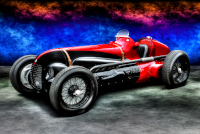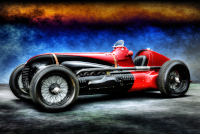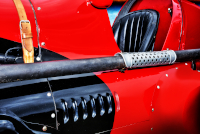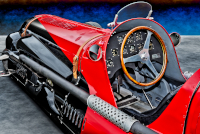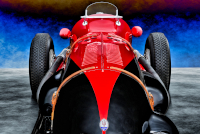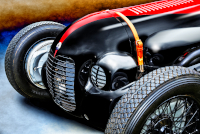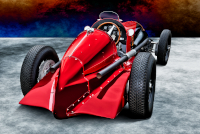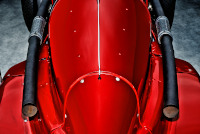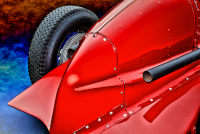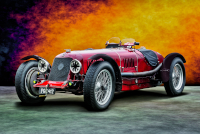Location:
Elegance at Hershey, 2018
Owner: Valerie Weaver Clark | Thompson, Connecticut
Prologue:
The V8RI occupies nothing more than one reference in the appendix of the Giorgio Nada Editore official history, that of Philippe Etançelin's victory at the 1936 Grand Prix de Pau, the car's only front line success.
However, the Maserati V8RI is the first V-8 Grand Prix car (not, for instance, the incredible Lancia D50 of 1954). And for Maserati, the V8RI is perhaps more significant in that it is the first with fully independent suspension. The car represents a spot of Maserati blue sky thinking, debuts a wealth of updated technology, and therefore presents a rather interesting test bed prior to the classically beautiful 8CTF.
Dennis Jenkinson found intrigue in the design, a departure from the norm, so we should take notice of the V8RI; it is something of an impossible dream, chance technology thrown at an indomitable adversary. And if, in the end, the V8RI did not become beloved by motorsport at large, this car, chassis #4504, was beloved by a man and his family. 'Poison Lil' to those who knew George Weaver, #4504 is more than its Grand Prix aspirations, an almost folkloric figure in post-War American road racing.
- - - - - - - - - -
► Image Source: Nikon D750 (24.3 MP)
References:
- Crump, Richard; de la Rive Box, Rob. "Maserati Sports, Racing and GT Cars from 1926" Third Edition, G.T. Foulis & Company for Haynes Publishing Group PLC, Somerset, England. 1992, page 69, 72
- Motorsport Magazine. "Veteran to Classic: Maserati V8RI" by Dennis Jenkinson, March 1990
- Historic Racing: A biography of Compte George Raphaël Béthenod de Montbressieux.
- International Motor Racing Research Center: Located in Watkins Glen, New York, the organization provides personal accounts of #4504, which is an important piece of local motorsports history, as well as the history of post-War racing in America.
- Racing Years: The full V8RI international race record from July of 1935 to July of 1937.
- UltimateCarPage: Reference to chassis #4501 and #4503, by Wouter Melissen, September 22, 2014.
- The Vintagent: "The 'Lost' Indian Four" by Paul d’Orléans.
To compete against the Germans in 1935, one should conceive of some terminal pace in the neighborhood of 290 km/h (better than 180 mph). The Mercedes-Benz W25 and Auto Union Type B cars vie for supremacy well in excess of that mark, leaving Alfa Romeo, Bugatti, and Maserati to question how in fact they calibrate their respective notions of speed.
Where Alfa Romeo and Bugatti are concerned, each brings forth an update of straight 8-cylinder technology first developed early in the decade, late evolutions of the P3 and Type 59. Not so Maserati.
Credit i fratelli Maserati for recognizing that the fight requires ingenuity. The V8RI uses a new cast-iron 90º V-8 along with a transaxle gearbox and independent front and rear suspension (of curious design, a Maserati habit).
To say that the new formula does not succeed is some understatement. Of 31 races entered from 1935 to 1937, the V8RI finishes just seven. Perhaps ironically, the first race the V8RI sees to completion is its lone victory—Philippe Etançelin in chassis #4503 at the 1936 Grand Prix de Pau for Scuderia Subalpina. But this race is not a championship event, and the German teams do not compete.
After Pau, the highest a V8RI will place is seventh. Through this period, the Maserati 8CM continues to race alongside, just as the Bugatti Type 51 carries on the banner of Molsheim's formative Type 35 underpinnings. Then in May of 1936, Alfa Romeo debut the 12C, their own attempt to meet the German advance with a new platform. Short of the main objective, Alfa recapture prime standing at least among the Italians and the French.
And yet, however much of an aberration the V8RI is, the car deserves better than to be forgotten. It is a chance taken.
From the first, the V8RI is faster than the last evolution of the 8CM. At about 280 km/h, the car ventures nearer to the German benchmark, but a lack of technical development hinders its progress and dogs its reliability.
Dennis Jenkinson devotes some time to the subject, saying of the V8RI, "it was an unsuccessful project by the Maserati brothers, but a very interesting one, and that interesting aspect is still very much alive." He sees the special nature of the car, and understands its turmoil.
In the end, Maserati return to the straight 8-cylinder and create the beautiful 8CTF, perhaps their best-known classic era race car. One can't quite say the V8RI is the 8CTF's sole predecessor; the latter car is a keen blend of the advanced V8RI and sturdy 8CM. But perhaps a nod to the Lancia D50 is appropriate. In this case, testing a V-8 nearly 20 years before the idea comes good is a valiant cause.
George Weaver and Poison Lil: Maserati V8RI Racing Special
As a rule, Maserati make exceptional American racing specials; they are roughly of the same formula, lightweight monoposto cars with supercharged handmade motors. And unlike other European Grand Prix cars, Maserati frequently travel across the Atlantic.
So, by the post-War era, all four V8RI cars have come to the United States; they run amok in early road racing—even on dirt tracks in the case of #4503—and generally live hard lives without opportunity to source factory parts or properly repair their engineering faults.
As with its sister cars, Maserati has sent chassis #4504 to the US before the war to compete in the Vanderbilt Cup and Indy 500. In Europe, the Argentine Compte George Raphaël Béthenod de Montbressieux (known in records as "Raph") piloted #4504. In the United States, Raph and Etançelin first attempt the Vanderbilt Cup in 1936, the latter managing ninth. In 1937, Americans Babe Stapp and Indy ace Wilbur Shaw take their turns with the same result, the latter managing ninth. (Other sources suggest Mauri Rose drives the car in period, so different records do not agree.) Chassis #4504 later fails to qualify for Indy in 1938 and 1939.
After the war, in 1947, George Weaver of Boston acquires #4504, disassembled, and rebuilds the car. At one point, Weaver also acquires #4501 and the motor from #4502 as a spare, his intention to go road racing in the dawn of the post-War era.
A word on George B. Weaver: He is the son of George Briggs Weaver, Sr. In the classic era, the elder Briggs Weaver serves as body stylist for Du Pont Motors, then works with E. Paul du Pont to develop the Indian Four motorcycle line. After Indian, Briggs Weaver joins Briggs Cunningham from 1950 to 1955, supporting Cunningham race car development and the Le Mans campaigns. So the Weaver family is well enough schooled in mechanics to build, race, and maintain the V8RI, which carries the family's racing heritage onward for another generation.
To propel such ambitions, in 1948, Cameron Argetsinger plans a six-lap race around a 6.6-mile circuit through Watkins Glen proper (not the modern race course). The New York Central agrees to stop service during the race, the first of its kind following the war, and the first ever Sports Car Club of America (SCCA) race.
According to the Saratoga Automobile Museum, George receives SCCA competition license No. 1, marking a host of post-War firsts. Also according to the museum, "Weaver named the car 'Poison Lil' after the Miller-powered sprint car built in 1932 by Californians Art Sparks and Paul Weirick that was on the grid next to the Maserati at the 1937 Vanderbilt Cup race." (Interesting, though I cannot verify either anecdote.)
For certain, Mister Weaver turns out in his V8RI for the Watkins Glen race, the fastest car present. He leads after lap one, but retires on lap two with brake failure. The win goes to Frank Griswold in an Alfa Romeo 8C 2900B, and second place to none other than Briggs Cunningham in his BuMerc special.
Then over the next few years, Weaver wins two SCCA races at Watkins Glen in 1949 and 1951. Now known as the Seneca Cup, the race remains on public roads, and in 1950 becomes part of the FIA-sanctioned International Sports Car Grand Prix of Watkins Glen. Competition stiffens with new Allard and Ferrari cars racing alongside former Grand Prix Bugatti and pre-War SS 100 Jaguars—Briggs Cunningham, John Fitch, and the Collier brothers included.
These are the best years for Poison Lil, though eventually, inevitably, internal damage puts the car out of commission. As many post-War owners do, Weaver fits steel cylinder sleeves to eek a bit more life out of the four-part cast-iron block. But as Jenkinson points out, "it is almost impossible to get a good seal at the top of a liner in a fixed-head engine," and further problems develop that render the motor defunct.
A lovely comment from New York race historian Bill Green, who followed George Weaver and #4504 through the early years of Watkins Glen racing: “Only George could make it go, and when it went it went.” The car remains with his family, and would require quite the effort to repair.
Commander Douglas Marr, the RAF pilot who acquired Etançelin's #4503, has laid the groundwork for restoring these V8RI cars, primarily with Tony Merrick in the UK. Chassis #4504 may benefit from the fresh castings Merrick developed, which Jenkinson suggests, but I cannot verify the fact. Seeing the bonnet removed at Hershey, the block is installed but disassembled. So Poison Lil has made numerous appearances throughout the mid-Atlantic as a rolling display. The car's obscurity and bespoke technical specification, combined with the plain difficulty of rebuilding a classic era Maserati, will make its return to form a task only fit for someone whose devotion matches that of George Weaver.
Motor: 4,788 cc 90º V-8, cast-iron block and head | 84 mm x 108 mm | 5.0:1 compression
Dennis Jenkinson writes of the design, "On the V8 RI engine the eight cylinders are in four blocks of two cylinders each. These two-cylinder blocks have integral heads and are in cast-iron with one inlet and one exhaust valve, and the single sparking plug situated to one side of the combustion chamber as the single overhead camshaft prevents the use of a central sparking plug."
Over time, private owners use stopgap measures to repair weaknesses in the blocks, namely by adding steel cylinder sleeves. However, the difference in expansion rates between cast-iron and steel creates new problems as compression forces gas in between, which in turn creates new cracks. These problems follow chassis #4502, #4503, and this car, #4504, throughout the post-War era. Their respective owners later pool resources to receive new blocks from Tony Merrick in the UK.
Of a properly sorted V8RI, Jenkinson writes of the initial test after piecing together #4503: "At low speed the V8 RI had a distinct V8 rumble, which none of us had ever heard before, but after some bedding-in running it was given a small burst of throttle to 3500 rpm and its character changed completely, sounding more like a Cosworth DFV or a Coventry Climax V8. Somewhat stunned, we repaired to the local for a drink..."
Valvetrain: SOHC, 2 valves per cylinder
Aspiration: Weber 50 DCO carburetor, Roots-type supercharger
The V8RI supercharger is a bespoke Maserati item. The unit attaches to the front of the motor, driven off the camshaft geartrain. Few if any are known to survive, (though #4504 presumably retains its original unit). The closest is a J.W. Marshall cabin blower developed in 1933 for the aircraft industry. That is the supercharger Commander Marr and Tony Merrick use when restoring #4503, Etançelin's car.
Power: 320 bhp at 5,300 rpm
Drivetrain: 4-speed transaxle gearbox, rear-wheel drive
Front Suspension: independent double-wishbones in hollow cast-steel, torsion bars, twin Watt's linkage, compound shock absorbers
As the name implies, "ruote independenti," the V8RI uses a new independent suspension design. At the front, the wishbones connect to conventional Watt's links in the lateral direction, which connect to two laterally mounted heavy-duty compound shock absorbers. We can see one of these shock absorbers through the grille slats, which looks a bit like an all-alloy friction damper. The shock absorbers sit on either side of a single-cast lateral brace beneath the radiator. The small circular cuts in the body are simple holes to permit rate adjustment.
Trailing arms extend rearward from the front axles and mount high at the back of the motor. Chassis #4503 and #4504 both appear to use these long control arms, whereas #4501 may not. Earlier Maserati cars throughout the 8C family may or may not omit front trailing arms as well. It seems Alfieri and Ernesto Maserati both devised many different ways to control suspension motion and track, and private owners dealt with these devices as they saw fit.
Rear Suspension: independent swing axles, semi-elliptic leaf springs, twin Watt's linkage
At the rear, interesting torsional bars fit longitudinally inside the leaf springs and attach to the rear axle half-shafts above and below. The purpose is to ensure that, as the unsprung weight of the wheel and tyre moves up and down with the suspension, the wheels do not move laterally (that is, front to back). Because the body tapers through the tail, the rear suspension attaches to separate rails held to the frame on tubular outriggers, as is common on previous designs. On chassis #4504, the streamlined fairings completely surround the suspension, so we cannot see the independent rear set-up.
Architecture: steel box-section frame and cross-members, aluminum coachwork
Kerb Weight: 750 kg (1,653.4 lbs)
Wheelbase: 2,700 mm (106.29 inches)
Top Speed: 280 km/h (173.9 mph)
Crump and de la Rive Box cite 240 km/h, incorrectly converted to 144 mph (whereas the figure should be 149.1 mph). Nevertheless, many sources have since quoted 144 mph without a second thought. Given the power-to-weight ratio and development of contemporary Grand Prix cars of similar output, the updated figure of 280 km/h is reasonable. This figure would also depend on gearing the car to compete in period Grand Prix racing against Alfa Romeo, no less the German silver arrows.
Etymology:
The 'V8RI' designation indicates the combination of a new 90º V-8 motor and independent suspension, or 'ruote independenti' in Italian. The V8RI is a departure from the conventional straight 8-cylinder Grand Prix car, and the first powered by a V-8.
In post-War American road racing, George Weaver names #4504, 'Poison Lil,' a name the Saratoga Automobile Museum suggest Mister Weaver chooses after a Miller-powered special that started next to the Maserati at the 1937 Vanderbilt Cup.
Figures:
Maserati build four V8RI Grand Prix cars, #4501 and #4502 in 1935, and #4503 and #4504 in 1936.
All four cars migrate to the United States, establishing a pre-War competition record in the Vanderbilt Cup and Indianapolis 500 from 1936 to 1939. And in post-War American road racing, #4501, #4503, and #4504 appear to be complete. At the very least, the motor from #4502 survives. But these are technically difficult cars to rebuild and maintain. Those that run today required about a decade each to restore, #4501 and #4503, which remain in operation in Europe.
The Special Aesthetic: Maserati and American Racing
With apologies to the 8CTF, perhaps no period Grand Prix car better fits within the American racing special concept as the V8RI, chassis #4504 in particular. The car has long worn its scalloped bicolor livery, and at a glance appears to be a bull-nosed automotive cousin of the Granville Gee Bee Model R. Fitted with a supercharged 90º V-8, the car is madly American in style and substance, albeit of a quixotic nature owing to the Maserati brothers' fanaticism.
Striking features include the bulbous intake for the front-mounted supercharger, paired with tapered cowls over the cam covers, which in the vee configuration fly well out beyond the fuselage. The nose is fully rounded, but with Maserati's period double-domino grille pattern cut into the alloy. Cowls cover the front suspension armatures and rear springs, the latter planed into sharp wings in keeping with the aeronautical theme.
Louvres line the bonnet, flanks, and underbody housings, with screws to hold the panels in place and customary leather straps to keep the lid on.
The isolated cowl on the left flank is interesting. Both #4503 and #4504 use long front trailing arms attached to high mount points just behind the exhaust headers; the mount I believe is visible just beneath the exhaust pipe. But period photos of V8RI cars do not show any mechanical protrusions in this vicinity. The shape of the cowl may simply support cooling and aerodynamics. In any case, #4504 is the most heavily bodied of the three complete cars, with #4503 sharing many traits.
Last Updated: Mar 26, 2025

